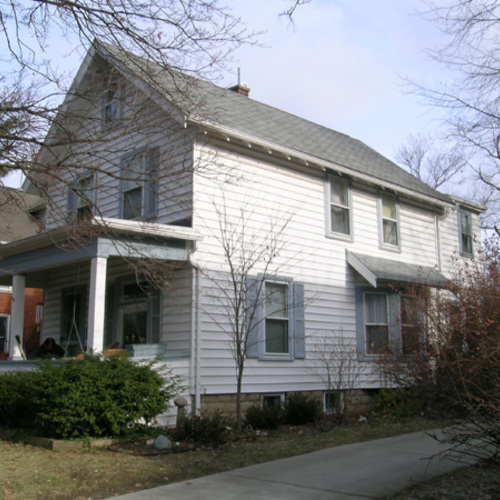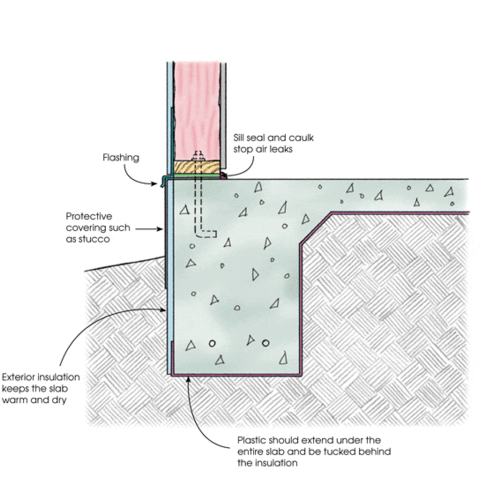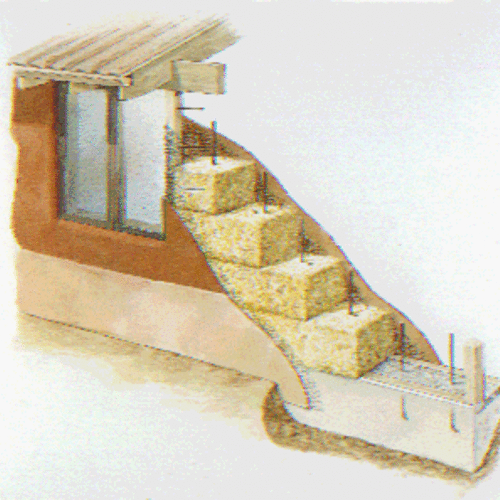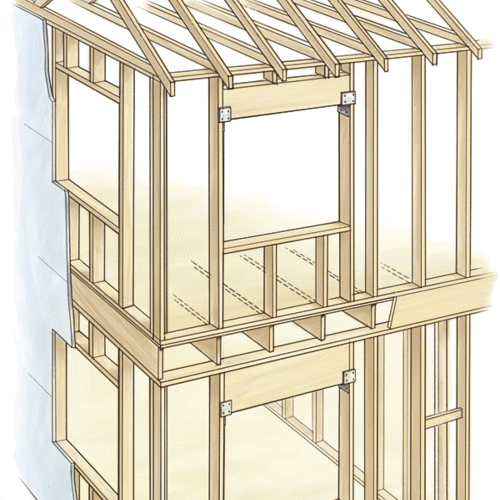ABOUT WALLS
###Separating the outside from the inside
The exterior walls of a house have several functions. Not only do they define the shape of a house, they also support the floors, walls, and roof. Equally important is their role in separating the house’s interior from the outdoors, and to do this effectively they have to block the weather with systems that insulate, shed water, and repel moisture and air infiltration.
While it’s important to understand the different roles walls play, if we treat them and their functions separately, we miss great opportunities to improve material efficiency, operating efficiency, and overall building performance. Green building integrates them all.
Wood-frame walls have been the predominant choice for houses in the United States for more than three centuries, with masonry walls a distant second. But today’s alternative products and techniques — many which are more energy efficient and have lesser environmental effects — are certainly worth examining.
A lot of time and materials go into building a house’s walls, and with the exception of a timber frame, all that structure is covered up when the project is finished — out of sight and out of mind. Yet decisions about wall construction have consequences that last as long as the building does, including how much maintenance it will need, how energy efficient the envelope will be, and how difficult the structure will be to repair or modify.
ABOUT CHOOSING A TYPE OF WALL
An overview
For a broad view of the issues that affect residential wall design, read How to Design a Wall.
Green factors
Energy efficiency. Where will the insulation go? Will the R-value of the completed wall be high enough? How will the wall be sealed against air leaks? A focus on energy efficiency pays dividends over time.
Sustainability issues. Can the resources used to build the structure be produced on a sustainable basis?
Local building requirements. Areas prone to hurricanes or earthquakes, for example, may have specific rules to help structures withstand extreme natural events that affect specific areas of the country.
Durability and initial cost. Keep in mind that differences in initial cost may not seem quite as dramatic when weighed against the expected life span of the house.
Combined functions. Wall systems that combine structure with finish have an inherent material efficiency advantage and should be seriously considered.
MORE ABOUT WALLS
Add more foam for a better wall
The performance of almost any wall, in any climate, can be improved by adding a layer of exterior foam. If the wall already has exterior foam, it can be made greener by making the foam thicker. Remember, depending on the type of foam and thickness, foam-sheathed walls may need to dry only to the interior. For walls with more than three inches of any foam or with any thickness of foil-faced polyisocyanurate foam, never include interior polyethylene or other impermeable interior finishes.
Siding is the first line of defense
Walls are a house’s “skin,” and as such must protect the building from rain, wind, and sun. Siding is the first line of defense, but how siding is applied and the kind of water-resistive barrier (WRB) installed beneath it have a lot to do with how durable the walls will prove to be. The skin also includes doors and windows, important components of a home’s thermal envelope but also sources of damaging air and water leaks if not properly installed.
Interior walls define spaces and affect livability
Floors and interior walls don’t keep weather out, but they often do more than just define spaces. How you lay out partitions can affect airflow, solar heat gain, natural lighting, and even how efficiently pipes, wires and ducts are laid out. Structural demands may dictate where interior walls and floors go, which is why you should plan your mechanical systems and framing at the same time.
Doors can help or hinder
Exterior wood doors just under 2 inches thick don’t offer much in the way of insulation, just R-2 or less. When weatherstripping is of poor quality or worn out, the effects are magnified. Doors don’t represent a huge amount of wall area, but they can help nullify all the effort of insulating outside walls carefully. Insulated doors will help, along with high quality weather-stripping. Window area in doors, along with sidelights, should be kept on the small side or eliminated altogether.
Storm doors may seem like an antiquated idea, but they can be helpful in reducing energy losses while providing an extra weather barrier. They’re especially useful when the primary door is exposed to the elements and not protected by a roof overhang or porch.
FURTHER RESOURCES
BuildingScience.com:
Impact Resistance of Advanced Framed Wall Systems with Insulating Sheathing as the Primary Sheathing
Bird’s-Eye View

Image Credits: Daniel Morrison/Fine Homebuilding #174
Besides strength, consider insulation and materials
Your first concern when building a home’s outer walls might be whether they are strong enough, but you should also consider several other questions, including how you can minimize material demands and how the walls will be insulated and air-sealed. There are quite a few ways to build a structural wall — each with pros and cons.
See below for:
Framing

Image Credits: Chuck Lockhart/Fine Homebuilding #174
Platform framing is an economical way to build a house
Use less wood, get better performance
Whether you call it optimum value engineering (OVE) or advanced framing, this is a way of reducing the amount of lumber used in a wood-frame building without compromising strength. Lower material and labor costs are two benefits; a third is reduced heating and cooling costs because this technique allows more room within the walls for insulation.
#
Use more wood, get better performance
Builders looking for the least expensive way to build exterior walls with high R-values usually settle on double-stud walls. By spacing parallel 2×4 walls 5 inches apart, a builder can leave room for a full 12 inches of cellulose insulation.
#Steel studs are better used for interior walls
Light-gauge steel framing can be attractive to builders who are turned off by the unpredictable quality of dimensional lumber. Galvanized steel studs are up to 50% lighter than wood, won’t rot, are uniformly straight, and are impervious to insect damage. Moreover, steel can readily be recycled into new building materials. Unless insulation is carefully installed, however, steel framing can weaken a home’s thermal envelope.
SIPs

Image Credits: Dan Thornton/Fine Homebuilding #188
SIPs combine insulation and structure in a single component
Most structural insulated panels (SIPs) consist of an inner core of insulating foam sandwiched between outer layers of oriented strand board. SIPs take the place of conventional wood framing and, like ICFs, sharply reduce energy losses from air leaks.
Timber Frame

Image Credits: Chuck Bickford/Fine Homebuilding #166
Timber frame is often combined with SIPs
Timber framing is a beautiful structural system, and if the wood is gathered on-site, it can also be a very green one. The beams are often left exposed inside a wrap of SIPs. Such an approach combines responsible resource use with improved energy performance.
ICF/Block

Image Credits: Brian Pontolilo/Fine Homebuilding #170
Building blocks make fast and tight walls
There are a number of masonry wall options, including conventional concrete blocks (CMUs) or blocks made from autoclaved aerated concrete (AAC). Those looking for a poured-concrete wall will probably gravitate to insulated concrete forms (ICFs). Unlike stick-built walls veneered with brick, stone, or block, these materials replace the wood frame altogether. They can be finished on the outside with a variety of materials, including stucco, fiber cement, or traditional wood siding.
ICFs are layered like a sandwich: Outer forms of insulating material hold an inner filling of concrete. The blocks have an internal network of voids. Steel reinforcing is put in place as the blocks are stacked, and the forms are then filled with concrete. Insulation and structure are intertwined.
ICFs are made by a number of manufacturers in a variety of types. One consists of an inner and outer layer of foam insulation separated by plastic or steel connectors. Another is made with a composite of cement and another material — recycled polystyrene, for example, or wood chips.
Some older forms of concrete walls used in homes include hollow concrete masonry units (CMUs). AAC blocks are durable and provide thermal mass.
Concrete block, AAC, and ICFs produce walls with a higher mass than standard wood-frame construction. Dense materials with high mass tend to be poor thermal insulators — that is, they have fairly low R-values. But that same high mass also can store a lot of heat, thus flattening out temperature extremes. Manufacturers often argue that the “effective R-value” of these wall systems is higher than conventional tests for thermal resistance would indicate. Using high-mass walls has energy benefits only under limited conditions in some, but not all, climates. Since “effective R-value” has no legal or scientific meaning, its use in marketing materials should set off alarm bells.
Natural Materials

Image Credits: Gary Williamson/Fine Homebuilding #131
Natural materials like straw and adobe perform well
Natural walls includes both old and new materials: straw bale, rammed earth, and adobe. Alternative walls are low-tech and rely on the use of indigenous or low-cost materials. They are well suited to specialty builders or owner-builders who are looking for alternatives to conventional wood framing.
GREEN POINTS
LEED for Homes Wall system choice influences thermal performance, potentially affecting 3 to 5 points in EA1 (Energy & Atmosphere), EA2, and/or EA3; MR2.2 (Materials & Resources) offers points for environmentally preferable wall framing and insulation materials.
NGBS Under Chapter 6, “Resource Efficiency”: up to 4 points for a detailed framing plan (601.4); up to 4 points for alternative wall systems (rammed earth, adobe, etc.) that are single component and do not require additional insulation as mass wall systems (601.9).











4 Comments
advanced framing
I have been reading many of your articles on advanced framing... 2x6 walls 24"oc. As I was planning the construction of our new cottage, I consulted with many subcontractors on advanced framing. Without exception, each one (insulation, framing crew, siding, trim) all advised me against going that route. They discussed issues like difficulty hanging cabinets on a wall 24"oc, wavey siding, the need to go to 5/8" drywall to avoid wavey interior looking walls, the lack of studs for wide window & door trim and even.... "the house will be too tight" ! How would respond to that ? I was surprised and disappointed.... I think I am going to go with 2x4 walls, 16"oc w/1" rigid foam sheathing.
Response to Alok J.
Alok J.,
1. The purpose of thermal insulation is to slow the transfer of heat through building assemblies (floors, walls, and roofs).
2. To learn more about the global warming contribution of XPS, see the following blog by Alex Wilson:
"Avoiding the Global Warming Impact of Insulation."
response to irwin
I am adding a large addition to my house and this is what I am doing; 2X4 studs 16" OC, OSB sheathing, 1" XPS, 3/8" air space, then Hardie panel. This meant that I could stay with 1/2" drywall, I would have another stud to screw the Hardie panels to, and my framer was already familiar with this kind of standard framing, AND 2/4s are cheaper in the long run I think. We'll see how it all works when I get finished later this fall. By the way, I am in Athens, Georgia, a mixed humid climate with 5 months of heating and 4 months of cooling.
Irwin Karwick
I posted your comment as a question in our Q&A forum, there may be more answers there. Here are some quick answers:
1. Cabinets can be hung with cleats or solid blocking installed behind drywall. See [How to Install Blocking to Anchor Cabinets](http://www.finehomebuilding.com/item/4927/how-to-install-blocking-to-anchor-cabinets-solidly)
2. Crowned and twisted studs cause wavy siding and drywall.
3. Backing can be added for wide trim, or simply don't skip the trimmer studs in your advanced framing scheme. See [The Future of Framing is Here](http://www.finehomebuilding.com/how-to/articles/future-framing-walls.aspx?collection=72770)
4. Stud spacing has nothing to do with how tight your house will be, BUT, houses can't be too tight, only under-ventilated. See Can Houses be “Too Insulated ” or “Too Tight"?
Log in or create an account to post a comment.
Sign up Log in